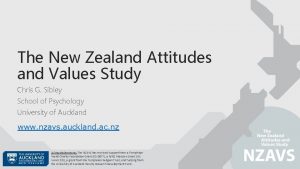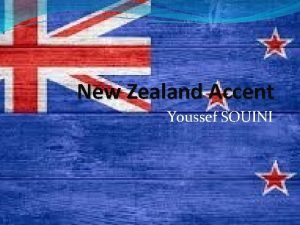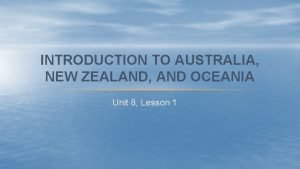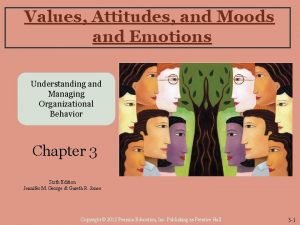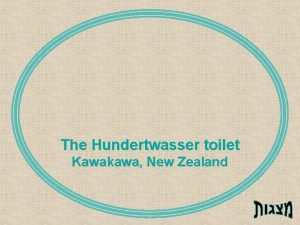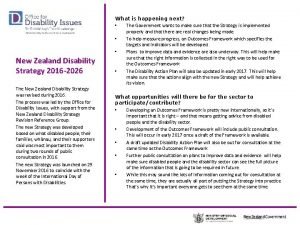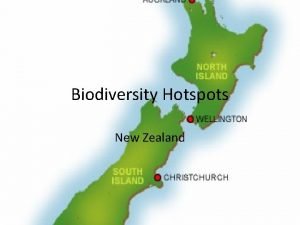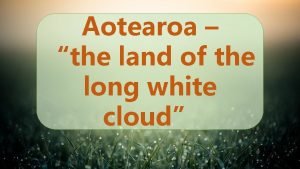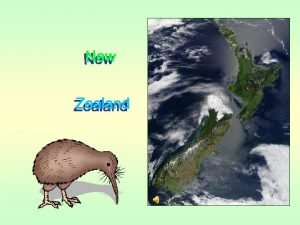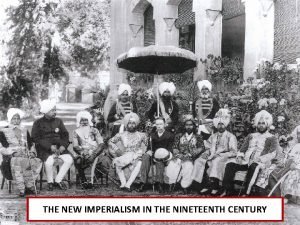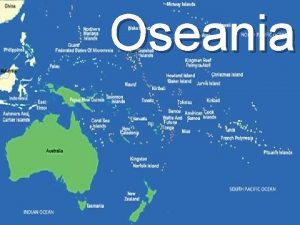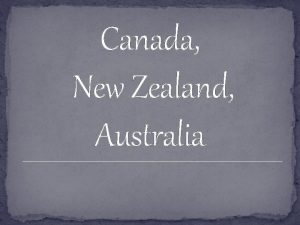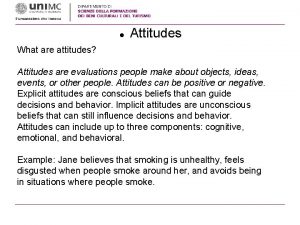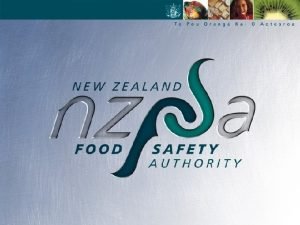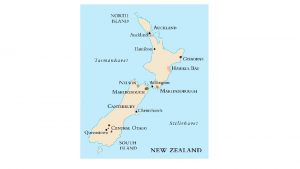The New Zealand Attitudes and Values Study Chris

















- Slides: 17

The New Zealand Attitudes and Values Study Chris G. Sibley School of Psychology University of Auckland www. nzavs. auckland. ac. nz Acknowledgements: The NZAVS has received support from a Templeton World Charity Foundation Grant (ID: 0077), a RSNZ Marsden Grant (ID: VUW 1321), a grant from the Templeton Religion Trust, and funding from the University of Auckland Faculty Research Development Fund.

The New Zealand Attitudes and Values Study • • • Planned 20 -year longitudinal study Currently in its 9 th year Postal questionnaire Focus on personality, social attitudes, values, identity, prejudice, experiences of discrimination, wellbeing and health outcomes. Unique to New Zealand. Sample frame drawn from NZ Electoral Roll Sample contains about 22, 000 unique people Large multidisciplinary research team At last count 119 published papers (55 led by a graduate student first author). Wave-to-wave retention about 80% The daily mail (random day) The daily mail during a busy period of data collection.

The New Zealand Attitudes and Values Study NZAVS Central Management Team NZAVS Advisory Board The board represents the different universities and organisations involved in the NZAVS. The advisory board ensures that different universities and partner organisations are consulted about the long-term strategic plan for the study. Professor Chris Sibley, School of Psychology, University of Auckland Dr Carla Houkamau (University of Auckland, Faculty of Business and Economics) Dr Fiona Kate Barlow, Australian Research Council Future Fellow, School of Psychology, University of Queensland Dr Sam Manuela, (University Auckland, Faculty of Science) Professor Joseph Bulbulia, School of Art History, Classics and Religious Studies, Victoria University of Wellington Dr Taciano Milfont (Victoria University of Wellington, Faculty of Science) Dr Danny Osborne, School of Psychology, University of Auckland Emerald Muriwai (Massey University, College of Health, SHORE & Whariki Research Centre) Associate Professor Nickola Overall (University of Auckland, Faculty of Science) The broader NZAVS research group contains a further 30 researchers Dr John Shaver (University of Otago, Division of Humanities) Dr Geoff Troughton (Victoria University of Wellington, Faculty of Humanities and Social Sciences) Dr Tim West-Newman (Ngā Pae o te Māramatanga) Dr Kumar Yogeeswaran (University of Canterbury, College of Science)

Our Goals • Answering questions focused on New Zealand-questions about how our values, attitudes, health, etc. , are changing over time. • Testing models of cause and effect for psychological variables that cannot be experimentally manipulated. • Building infrastructure for longitudinal research and the analysis of attitudes and values in New Zealand. • Providing independent data and analysis on socially relevant issues in New Zealand to policy makers and health professionals. • Providing data from New Zealand for larger collaborative cross-cultural research, and helping set up parallel studies in other nations. • Producing a database that will be of use for future generations of researchers in New Zealand. Graph showing meshblock clustering of NZAVS participants. From Milfont et al. (2014). PLo. S ONE, Fig. 1.

The questionnaire • Eight page questionnaire, completed each year. • Also an online version • Organized into ‘content blocks’ most included each year, some on a 2 or 3 year rotation. • All the usual social-psych suspects: Big-Six Personality, Social Dominance Orientation, Right-Wing Authoritarianism, Ambivalent Sexism, Patriotism, Nationalism, Affect toward different ethnic groups, Attitudes toward Multiculturalism, Immigration, Schwartz Values, Subjective Wellbeing, Satisfaction with Life, Body Image, Self-Esteem, Psychological Distress, Health ratings, climate change beliefs, attitudes toward the environment, intergroup contact (positive and negative), voting behaviour, political party support, perceived discrimination, felt belongingness, color-blind ideology, ethnic identity, and so on and so forth.

Sample size Time 1 - 2009 Time 2 - 2010 Time 3 - 2011 Time 4 - 2012 Time 5 - 2013 Time 6 - 2014 Time 7 - 2015 Time 8 - 2016 N 6, 518 4, 442 6, 884 12, 181 18, 261 15, 822 13, 943 12, 443 Retention of Time 1 Retention of previous year 67. 9% 60. 1% 62. 2% 60. 4% 57. 2% 51. 0% 47. 0% 67. 9% 79. 5% 83. 7% 80. 8% 81. 5% 79. 3% 78. 4%

Response timeline Updated from: Satherley et al (2015). PLo. S ONE, Fig 1.

NZAVS Retention and Panel Attrition Analysis of 6385 participants from Wave I to Wave IV • Explicit withdrawals (n = 499, 7. 8%) • Lost participants (n = 1065, 16. 7%) • Intermittent respondents (n = 1733, 27. 1%) • Constant respondents (n = 3088, 48. 4%) • For example, more likely to lose men, Māori and Asian peoples, younger people, those with lower levels of education, and those for whom English is a second language. Source: Satherley et al (2015). PLo. S ONE, Table 4.

How representative are we? Comparison of men and women in the T 4 (2012) NZAVS and 2013 New Zealand Census Comparison of ethnic affiliation in the T 4 (2012) NZAVS and 2013 New Zealand Census Comparison of distribution across region in the T 4 (2012) NZAVS and 2013 New Zealand Census

How representative are we? Bias reflects the extent to which the NZAVS systematically over or underestimates support for a given party relative to the TVNZ polls. Accuracy reflects the extent to which the NZAVS reliably tracks change in political party support over time relative to the TVNZ polls. Source: Sibley et al. (2017). Political Science, Fig 1 & Table 3. On election day, Sept 20 th, 2014 • National: 47% • Labour: 25%

How representative are we? 2016 Referendum: 56. 6% to retain current flag 2012 NZAVS: “Should the design of the New Zealand flag be changed? ” 53. 1% opposed changing design. Source: Report of the Electoral Commission on the first and second referendum on the NZ flag. http: //www. elections. org. nz/events/referendums-new-zealand-flag-0/referendum-two-march 2016/report-electoral-commission-first Source: NZ Herald. http: //www. nzherald. co. nz/nz/news/article. cfm? c _id=1&objectid=11612553

Changing the flag… Source: Satherley, N. , Yogeeswaran, K. , Osborne, D. , & Sibley, . C. G. (revise and resubmit). If they say ‘yes’, we say ‘no’: Partisan cues increase polarisation over national symbols. Psychological Science.

Changing the flag… Source: Satherley, N. , Yogeeswaran, K. , Osborne, D. , & Sibley, . C. G. (revise and resubmit). If they say ‘yes’, we say ‘no’: Partisan cues increase polarisation over national symbols. Psychological Science. Source: Nicole Satherley’s Ph. D.

Geographic Information • New Zealand is unusual in having rich census information about each area unit/neighborhood of the country available for research purposes. The smallest of these area units are meshblocks. Figure 1. Geographic hierarchy of areas in New Zealand. (Available at: http: //www. stats. govt. nz/methods/classifications-and-standards/geographic-hierarchy. aspx)

Geographic Information The NZAVS focuses on data at two levels: • Area Units (2020 units, median = 1977 residents per unit) • Wards (257 units, median = 6378 residents per unit) Regional deprivation, proportion in income bands, ethnicity, gender, immigration, home ownership, birthplace, cigarette smoking, qualifications, education, sources of income, employment status, job type, number living in household, relationship status, access to telecommunications, hours in employment, number of bedrooms, and so on…


The NZAVS Research Group Dedication: to the 23, 206 people who have generously taken the time to complete one or more of our annual NZAVS questionnaires. Over the first seven years of the study you, our participants, have completed a combined total of 78, 033 questionnaires, which we estimate has taken a total of 67, 629 hours. Thank you for making this research possible (and we hope you are not too fatigued to see out the remaining 12 years of the study)!
 New zealand values and attitudes
New zealand values and attitudes Slidetodoc.com
Slidetodoc.com Lesson 1 an introduction to oceania
Lesson 1 an introduction to oceania Internal medicine society of australia and new zealand
Internal medicine society of australia and new zealand Dominant work values in today's workforce
Dominant work values in today's workforce Values and attitudes in the workplace
Values and attitudes in the workplace Values attitudes and job satisfaction
Values attitudes and job satisfaction Values attitudes moods and emotions
Values attitudes moods and emotions Hundertwasser toilets nz
Hundertwasser toilets nz New zealand national sport
New zealand national sport New zealand disability strategy
New zealand disability strategy When was new zealand discovered
When was new zealand discovered New zealand alpha lipid colostrum
New zealand alpha lipid colostrum New zealand hotspot
New zealand hotspot New zealand official languages english
New zealand official languages english Capital of new zealand
Capital of new zealand Natives of new zealand
Natives of new zealand Urfolk new zealand
Urfolk new zealand
